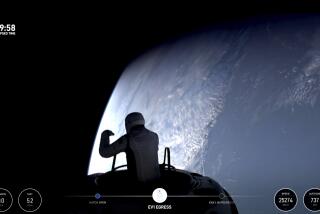Dale Gardner dies at 65; spacewalker on first satellite rescue mission
- Share via
Wearing a nitrogen-powered jet pack, Dale Gardner stepped from the space shuttle, alone and untethered, 224 miles above Earth.
Armed with a 5-foot probe called a stinger, Gardner drifted toward a wayward satellite, the Westar 6, which was spinning slowly, 35 feet away.
When he got close enough Gardner inserted the stinger into the orbiter’s spent rocket nozzle and brought it to a halt.
“I got it,” he exclaimed.
The mission to salvage the Westar and another communications satellite, the Palapa B-2, in November 1984 marked a high point of the space shuttle program, feeding a growing sense of NASA’s infallibility that would end just a year later, when the Challenger exploded just after launch over Florida.
Gardner, one of two spacewalkers on the mission, died Feb. 19 in Colorado Springs, Colo., according to NASA, which did not give a cause of death. He was 65.
“That mission was extraordinarily difficult, and it was made easier by the brilliance of Dale Gardner,” said the mission’s commander, Frederick H. Hauck.
The eldest of three children, he was born to Alice and William Gardner in Fairmont, Minn., on Nov. 8, 1948. After receiving a bachelor’s degree in engineering from the University of Illinois, he joined the Navy, became a flight navigator involved in the testing of the F-14 Tomcat and obtained the rank of commander.
He was selected as an astronaut candidate by NASA in 1978 and flew on his first mission into space aboard the Challenger on Aug. 30, 1983.
His second mission, on Discovery, which began on his 36th birthday the next year, would be the first-ever salvage mission in space.
The five-member crew first launched two satellites, then began the operation to retrieve the Westar and Palapa, each worth $35 million. Both were stuck in useless orbits after their positioning rockets misfired.
Palapa was spinning like a disco ball in the abyss. “Holy smoke,” Gardner said, “look at that satellite.” Mission commander Hauck remarked, “There sure isn’t any problem seeing this baby.”
Gardner’s colleague Joseph P. Allen, a Yale-educated physicist, stepped into space first, using a nitrogen gas-powered pack called a manned maneuvering unit.
Because the satellites were not made to be rescued, they had no hooks to grip, so the crew used the improvised stinger, which had flanges at the tip to grab the inside of the exhaust nozzle of the satellite’s spent rocket.
The Palapa operation didn’t go as planned. The shuttle’s robotic arm attached to the stinger, but Gardner struggled to install a clamp that the arm would use to guide the satellite into the cargo bay. Allen, who at 130 pounds was the nation’s lightest astronaut, had to push and steady the barrel-like, 1,200-pound satellite while Gardner feverishly worked to secure it.
“Joe, I assume you are comfortable there,” Gardner said.
“Not very,” Allen replied haltingly, then added. “I’m doing OK. The view is out of this world.”
After 90 minutes, Gardner had locked three pins in place. “All right, we got it, we got it.”
When they reached Westar early on Nov. 14, they took a different tactic. Gardner propelled out to the craft, inserted the stinger and pushed the satellite toward Allen, who was locked in foot restraints on the edge of the robotic arm. On the flight deck, astronaut Anna Fisher maneuvered the arm to bring it toward the cargo bay.
At one point, Gardner’s torque wrench floated off from its tether.
“My God, you just lost the wrench!” pilot David Walker shouted.
“Where did it go? Where did it go?” Gardner shouted back in alarm.
The wrench was critical – and if not found, could become a grave danger upon reentry. Gardner spotted it and shot across the bay to grab it.
When the Westar was bolted down next to Palapa, Gardner posed for a photo holding up a “For Sale” sign in front of them, with Earth as the backdrop.
The mission was celebrated as a stunning feat of skill and improvisation.
After that operation Gardner was scheduled to be on the first space shuttle mission to be launched from Vandenberg Air Force Base in California into polar orbit. But the Challenger disaster scuttled those plans.
He grew frustrated waiting to fly again and quit the program in August of 1986. In his two missions he logged 337 hours in space and 225 orbits of Earth.
He went on active duty in the Navy again, was promoted to captain in 1989 and became the deputy director for Space Control at Peterson Air Force Base in Colorado Springs. He later went into the private sector, working for TRW and Northrop Grumman in Colorado Springs and the National Renewable Energy Laboratory in Golden, Colo.
He retired in 2013 and lived in the mountains of Divide, Colo., with his wife Sherry, who survives him along with two children, two stepchildren and two grandchildren.
More to Read
Start your day right
Sign up for Essential California for the L.A. Times biggest news, features and recommendations in your inbox six days a week.
You may occasionally receive promotional content from the Los Angeles Times.







